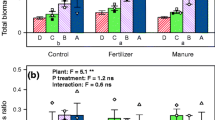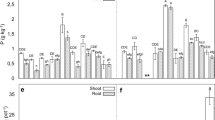Abstract
The growth of four tropical legumes (Cajanus cajan, Sesbania aculeata, S. rostrata, and S. speciosa) used as green manures in the tropics was studied in a glasshouse experiment. Two acid sulfate soils (Typic Sulfaquept, Bang Pakong Series; and Sulfic Tropaquept, Rangsit Series) were adjusted to four pH levels: 3.8 or 4.0 (original soil pH), 4.5, 5.5, and 6.5 (amended with lime). Dry weight was determined 49 days after sowing. Concentrations of N, P, K, Ca, Mg, Fe, Mn, and Al were also determined in aerial plant parts at harvest.
The legumes responded differently to soil acidity and liming, but not to soil type. Cajanus cajan had the highest biomass production, followed by S. aculeata, S. rostrata and S. speciosa, in this order. The N concentration closely paralleled biomass production, suggesting that the growth of symbiotic rhizobia and nodulation were perhaps more susceptible to soil acidity than were the host plants. Liming to pH 5.5–6.0 was recommended for the legumes' growth based on the quadratic relationships between dry-matter yield and soil pH. In the unlimed soils, the Ca concentration in C. cajan and S. aculeata (0.32%) was twice as high as that in the two low-yielding legumes (0.15%). Furthermore, plant Ca increased exponentially (or quadratically in case of S. speciosa) as lime additions increased. It was estimated that for adequate growth, the Ca requirement in the shoot dry matter was approximately: C. cajan 1.2% Ca, S. aculeata 0.8%, S. rostrata 0.6%, and S. speciosa 0.4%. In contrast with Ca, the concentration of Fe, and to a lesser extent Mn, was significantly lower in C. cajan and S. aculeata than in S. rostrata and S. speciosa. The ratio of Ca to Al in plant tops was used to characterize plant tolerance to soil acidity, and to quantify the critical Al concentration in the plants. It appears that ≥ 90% maximum growth was attained only when Ca/Al was ≥ 150 for C. cajan and S. speciosa, ≥ 200 for S. rostrata, and ≥ 300 for S. aculeata. Cajanus cajan tolerated up to 80 mg Al kg-1 in the shoot dry matter, whereas significant growth reduction occurred in the Sesbania species at levels > 30 mg Al kg-1.
Similar content being viewed by others
References
Alva A K, Edwards D G, Asher C J and Blamey F P C 1986a Relationships between root length of soybean seedlings grown in aluminum-toxic soils. Soil Sci. Soc. Am. J. 50, 656–661.
Alva A K, Asher C J and Edwards D J 1986b The role of calcium in alleviating aluminum toxicity. Aust. J. Agric. Res. 37, 375–382.
Barnhisel R and Bertsch P M 1982 Aluminum. In Methods of Soil Analysis, Part 2, Chemical and Microbiological Properties. 2nd. ed. Eds. A LPage et al. pp 275–300. Soil Sci. Soc. Am. Inc., Madison, WI.
Bray R H and Kurtz L T 1945 Determination of total organic and available forms of phosphorus in soils. Soil Sci. 59, 39–45.
Chapman H D 1965 Cation exchange capacity. In Method of Soil Analysis, Part 2. Eds. CABlack et al. Soc. Agron. Inc., Madison, WI.
Evans D O and Rotar P P 1987 Sesbania in Agriculture. Westview Tropical Agriculture Series, No. 8. 192 p. Westview Press, Boulder, CO.
Evans D O, Yost R S and Lundeen G W 1983 A selected and annotated bibliography of tropical green manures and legume covers. Res. Ext. Series No. 028. 211 p. College of Tropical Agriculture and Human Resources, Univ. of Hawaii.
Freeney J R 1986 Analytical methods for determining sulfur in soils and plants. In Proc. Int. Symp. on Sulfur in Agric. Eds. Sam Portch and Ghulam Hussair pp 67–84. Bangladesh Agricultural council and the Sulfur Institute.
Gee G W and Bauder J W 1982 Particle size analysis. In Methods of Soil Analysis, Part 1, Chemical and Microbiological Properties. 2nd. ed. Eds. A LPage et al. pp 383–412. Soil Sci. Soc. Am. Inc., Madison, WI.
Helyar K R 1979 Effects of aluminum and manganese toxicities on legume growth. In Mineral Nutrition of Legumes in Tropical and Subtropical Soils. Eds. C SAndrew and EJKamprath pp 207–231 CSIRO, Australia.
Joshua D C, Anjali S B, Gadgil J D and Bhatia C R 1989 Sesbania rostrata Brem. A stem nodulating legume—its potential as green manure crop. Proc. Inter. Symp. Biological Nitrogen Fixation Associated with Rice Production. CRRI. Cuttack, India.
Jugsujinda A, Tadashi Y and van Breemen N 1978 Aluminum toxicity and phosphorus deficiency in acid sulfate soils of Thailand. IRRI Int. Rice Res. Newsl. 3,1.
Licudine D L and Hue N V 1992 Residual liming effects of organic manures. Agron. Abstr. p. 283.
Mappaona M K and Yoshida S 1993 Biomass production and nitrogen fixation of tropical green manure legumes grown under pot condition. Japan J. Trop. Agr. 37, 124–127.
Nakano H, Sugimoto A, Nakagawa H, Matsuoka M, Terauch T, Owaki Y, Shibano K and Momonoki T 1992 Evaluation of legume species for use as green manure crops in the sub-tropics in Japan. pp 23–26. Tropical Agr. Res. Center. Res. Highlights '92.
Parkpian P, Pongsakul P and Sangtong P 1991 Characteristics of acid soils in Thailand: A review. In Plant-Soil Interaction at Low pH. Eds. R J Wright, V C Baligar and R P Murrmann. pp 397–405. Proceeding of the Second International Symposium on Plant-Soil Interactions at Low pH. Beckley, West Virginia.
Reuter D J and Robison J B 1986 Plant analysis: an interpretation manual. pp 62–63. Inkata Press, Melbourne, Australia.
Singh Y, Singh B and Khind C S 1992 Nutrient transformation in soils amended with green manures. pp 237–310. Adv. Soil Sci., Springer-Verlag, NY.
Suthipradit S 1989 Effects of aluminum on growth and nodulation of some tropical crop legumes. Ph. D. thesis, Univ. of Queensland, Brisbane, Australia.
Wallis E S, Woolcock R F and Byth D E 1988 Potential for pigeonpea in Thailand, Indonesia and Burma. CGPRT No. 15. Bogor. Indonesia.
Yost R S and Evans D O 1987 Green manures and legume covers in the tropics. Research Series 055. 40 p. Hawaii Institute of Tropical Agriculture and Human Resources, Univ. of Hawaii.
Author information
Authors and Affiliations
Rights and permissions
About this article
Cite this article
Poolpipatana, S., Hue, N.V. Differential acidity tolerance of tropical legumes grown for green manure in acid sulfate soils. Plant Soil 163, 131–139 (1994). https://doi.org/10.1007/BF00033949
Received:
Accepted:
Issue Date:
DOI: https://doi.org/10.1007/BF00033949




